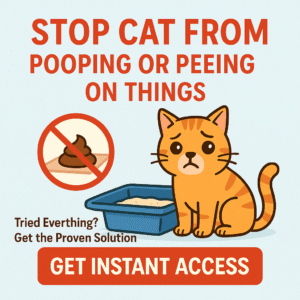Is your cat peeing outside the litter box, on furniture, or marking territory around your house? You’re not alone—and your cat isn’t doing it out of spite. In fact, peeing problems are one of the most common behavioral issues in domestic cats, and they usually stem from stress, confusion, or an unmet need.
The good news? With the right approach, you can fix this problem for good—and restore harmony to your home.
What Causes Cat Behavior Problems Related to Peeing?
Cat behavior problems involving peeing usually result from emotional stress, environmental triggers, poor litter box setup, or unresolved conflict with other pets. Even once a medical issue is ruled out, your cat’s behavior often reflects deeper psychological or territorial concerns.
Top Behavioral Reasons Why Cats Pee Inappropriately
1. Territorial Marking
One of the most misunderstood behaviors in cats, marking isn’t about rebellion—it’s about ownership and security. Cats will spray or urinate in certain areas to signal control or respond to perceived threats.
- Triggered by new people, pets, or outside animals
- Usually occurs on vertical surfaces (walls, doors, furniture)
- More common in unneutered males but can affect any cat
2. Litter Box Aversion
Cats may begin avoiding their litter box due to one or more negative experiences. That can include pain while urinating (UTI), dirty litter, or being startled while inside.
- Box smells too strong or is dirty
- Litter is uncomfortable, dusty, or perfumed
- Covered box traps smells or feels claustrophobic
- Bad experience inside the box (pain, loud noise, aggression)
3. Stress and Anxiety
Cats thrive in consistent, low-stress environments. Sudden changes—such as moving homes, new family members, or changes in daily routine—can lead to inappropriate urination.
- Changes in family schedule or dynamics
- Home renovations or new furniture
- Conflict with other pets
- Lack of stimulation or environmental enrichment
4. Insecurity or Attachment Behaviors
If your cat is peeing on your bed, clothes, or personal belongings, they may be anxious and seeking comfort. Your scent provides a sense of safety when they feel vulnerable.
- Separation anxiety or loneliness
- Peeing occurs while you’re away or after a stressful event
- More common in single-cat homes or rescues
5. Habitual Behavior
Once a cat pees in a certain spot, they’re likely to return there. This happens when the scent remains—even if you can’t smell it. This can turn into a learned behavior or habit if not corrected.
How to Stop Behavioral Peeing for Good
Step 1: Rule Out Medical Issues First
Even if the behavior appears emotional, always consult a vet first to rule out urinary tract infections, kidney issues, or pain-related conditions. A urinalysis and physical exam can save time and unnecessary stress.
Step 2: Clean All Soiled Areas Thoroughly
- Use enzyme-based cleaners to eliminate urine scent completely
- Do not use ammonia-based products (they mimic urine scent)
- Block access to previously soiled areas until the behavior improves
Step 3: Optimize the Litter Box Environment
- One box per cat, plus one extra
- Place boxes in quiet, low-traffic areas
- Test unscented, soft-texture litter types
- Scoop daily and wash the box weekly
- Try open-top boxes for better airflow and access
Step 4: Reduce Stress Triggers
- Use calming pheromone diffusers like Feliway
- Stick to consistent feeding and play routines
- Offer vertical spaces (cat trees, window perches)
- Give your cat a safe zone where they won’t be disturbed
Step 5: Retrain Your Cat Using Cat Spray No More
Even after you remove the stressor and clean up the mess, you need to reset your cat’s behavior. That’s where Cat Spray No More comes in.
Cat Spray No More: Your Permanent Fix for Cat Peeing Behavior
Cat Spray No More is a complete training and behavior modification program designed to stop inappropriate urination once and for all. Unlike surface-level solutions, it teaches you how to:
- Identify emotional and environmental triggers
- Use natural scent and deterrent techniques
- Retrain your cat with positive, humane methods
- Break the cycle of spraying, marking, and stress-related peeing
Thousands of cat owners swear by it. If you’re done trying sprays, punishments, or endless cleanups, this guide gives you a practical, step-by-step solution.
Click here to get Cat Spray No More and finally put an end to your cat’s peeing problems—for good.
Quick Behavior Fix Table
| Cause | Behavior | Solution |
|---|---|---|
| Territorial Marking | Spraying on walls or furniture | Spay/neuter, reduce stress, use Cat Spray No More |
| Litter Box Aversion | Avoids box, pees on carpet or soft surfaces | Change litter, clean box daily, add more boxes |
| Stress or Anxiety | Peeing in new places, restlessness | Calming tools, safe zones, consistent routines |
| Habit or Routine | Repeated peeing in the same spot | Enzyme cleaner, behavior retraining |
Final Thoughts
Behavioral peeing doesn’t mean your cat is broken or bad—it means they’re stressed, confused, or trying to reclaim a sense of safety. Your job is to understand what they’re trying to tell you, respond calmly, and offer solutions that work.
And when you’re ready to stop the cycle and enjoy a clean, stress-free home again, get Cat Spray No More and take control of the situation—for good.
